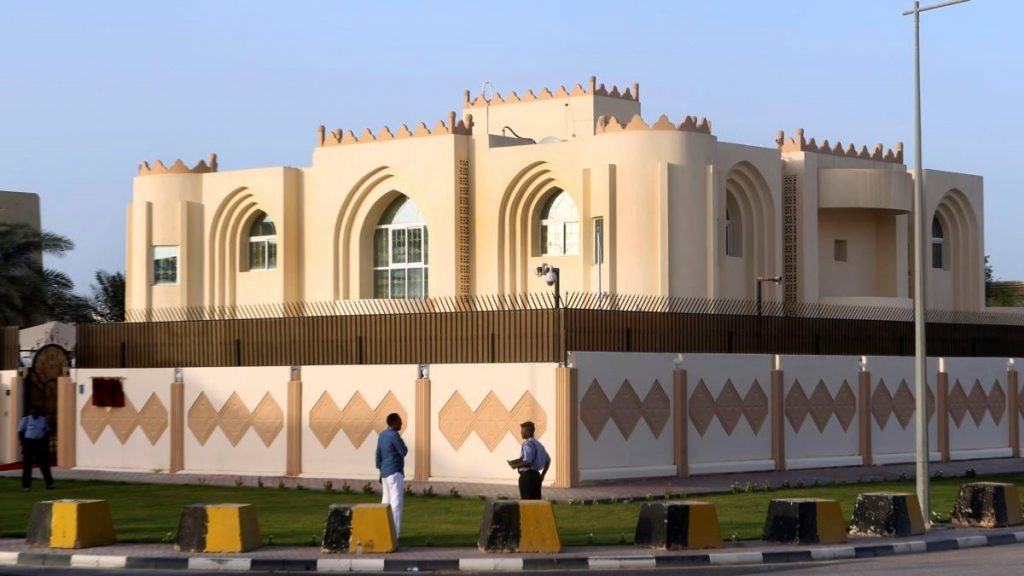When we think of terrorist groups, we have a lot of, usually accurate, preconceived notions. Chief among them is the image of desert warriors in the mountains or caves of a bombed-out wasteland. When you look at most footage of insurgents on the ground, it seems pretty accurate. ISIS certainly seemed like that in their dying days and footage of Al Qaeda, and the Taliban is rarely much nicer. Sure, we know that Osama was caught in a secret luxury compound, but it was still the shady dealings of an ‘under the radar’ terrorist in hiding from the world.
That’s why it may be surprising to learn that the Taliban essentially have a public embassy. It’s not an ’embassy’ in the strictest sense, but it’s hard to deny that it functions that way. Based in Doha, the capital of Qatar, the Taliban office is a legal, official channel by which foreign powers can negotiate directly with Taliban officials.
Something you may have noticed is that the Afghanistan war has gone absolutely fucking nowhere since the Soviets invaded back in 1979. It has been perpetual war since all the way back then, with the Taliban spearheading the conflict for most of that time. For a period of five years between 1996 and 2001, Afghanistan was ruled de-facto by the Taliban and was known as the ‘Islamic Emirate of Afghanistan.’ While not internationally recognized by most powers, it was the primary governing body in the country and commanded a certain degree of clout from its neighbours, even if it was heavily reviled by most of the world.
After 9/11, the Taliban were on the chopping block owing to their close ties with Al Qaeda. The Americans invaded, and Afghanistan has continued to be in war ever since. I don’t think it can be overstated just how big of a fucking quagmire the whole conflict has been. In terms of territory, the Taliban has been gaining ground over the last few years while their membership has remained either consistent or grown continuously in spite of losing tens of thousands of members over the years. Unlike ISIS, which has been nearly militarily defeated, and unlike Al Qaeda, who are predominantly small and secretive anyway, the Taliban cannot be defeated conventionally or reduced to a level of strategic insignificance. Diplomacy is necessary to make any headway.
This was recognized quite a long while ago. But you might notice that the model of ‘random insurgents in the desert’ doesn’t make for easy negotiation tactics. Nobody knows who to talk to, where they are, how to contact them or if they’re even still alive. The situation was unworkable, so in 2010, an olive branch was extended whereby senior Taliban leaders would be able to live and operate an office in a neutral country where negotiations could take place. Plans initially were for the country to be Saudi Arabia or Turkey. Nations that didn’t necessarily oppose the Taliban but which had working relations with the Afghan government. The Taliban instead pushed for Qatar, which they felt was more neutral and had less close ties with Afghanistan. The US agreed, and after some grumbling, the Afghan government did as well.
What began as a trickle of leaders gradually grew until there was a large, continual presence of Taliban officials in Qatar, and an office could officially be opened to accommodate them. This happened in June of 2013, and instantly, there was backlash. You see, the office was just intended as a negotiating place for Taliban leaders to exist in safety and be easily contacted for regular conferences and negotiations. The Taliban, however, seemed to want to make the office into an embassy. The sign on the office as it opened declared it as being the office of the ‘Islamic Emirate of Afghanistan,’ referring to the country’s name from when it was wholly controlled by the Taliban, with the flag from that era flying proudly from within the grounds of the office.
Afghanistan protested and went so far as to postpone peace talks until the matter was settled, forcing Qatar to intervene and have the iconography removed. While the symbolism may be gone, there’s still a lot of feeling that the office is little more than a self-proclaimed ‘government in exile’. Taliban leaders live in relative luxury on the Qatari government’s dime, with many among them being known to have been responsible for large scale atrocities. Naturally, this just leads to even more controversy, with a prominent case being that of the so-called ‘Taliban Five,’ who were Guantanamo Bay prisoners who were exchanged for a US soldier held by the Taliban and who now live in Qatar. While their movement is restricted, it’s questionable to what degree this can be assured.
Curiously, the Taliban office has found itself as part of an ongoing diplomatic crisis for Qatar. On the 5th of June 2017, Saudi Arabia, the UAE, Bahrain and Egypt all cut ties with Qatar, citing the regime’s supposed support for terrorist groups such as Al Qaeda, ISIS and, indeed, the Taliban. Now, this would be pretty normal. Anti-terrorism is a big deal, and geopolitics is an even bigger deal when we tie it in with the various factions vying for influence. But eyebrows soon raised when it became clear that the UAE was pissed at Qatar for poaching the Taliban office from them. It was seen that having the Taliban office there boosted Qatar’s international prestige, making it a key center for global policy in the middle east. The UAE was initially poised to be the main host of the office, so losing the chance at that prestige was seen as a slight against them. Force Qatar to drop the Taliban, and they’ll get moved to Abu Dhabi. Makes sense, right? Stupid, but still makes sense.
As it stands, the practical use of the office has been questionable. There’s been prisoner exchanges, occasional ceasefires and a few more concrete solutions. Most notable was the February 2020 agreement, which saw the Taliban agree to drop support for Al Qaeda in return for a phased US military withdrawal. As a result, Taliban attacks on the US have dropped significantly. Within Afghanistan, however… It’s a very different picture.



